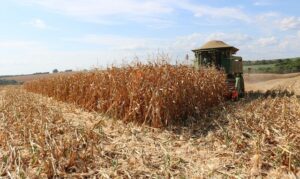Corn producers were the most affected by the lack of rain in Rio Grande do Sul, according to the new projection for summer crop production. Therefore, the data were released by the Department of Agriculture, Livestock and Rural Development together with Emater.
As of the survey, corn production is down 1.2 tonnes from the August 2019 survey, a percentage of 21.1%.
The new estimates were presented this Tuesday morning (3) at the 21st Expodireto Cotrijal, in Não-Me-Toque, in the north of the state. Although the survey was carried out in the second half of February, rice, bean, corn, silage corn and soybean plantations were analyzed.

According to the Secretary of Agriculture of RS, Covatti Filho, it will be necessary to create new actions to circumvent the drought in production.
“The state is experiencing a great drought. The lack of rain for the next few days could make the situation even worse.”
Next, the most affected production was corn silage, which is used for animal feed. According to the data, there was a drop of 20.7% in production.
“The South region concentrates most of the poultry and pork production. There is, in this and other regions, an alert regarding the possibility of a lack of corn production or of this product agricultural get very expensive.
The demand in 2019 was very high and most corn enters the market only in the second half of the year, with the off-season. Cereal prices are sustained and a smaller supply should contribute to this scenario of high prices, especially until we have a more concrete idea of the results of the off-season”, he says.
second corn crop
INTL FCStone also estimates a slight cut in the production of safrinha corn, from 72.1 million tons, projected in December 2019, to 71.97 million tons. The decrease was conditioned by the revision of the area in some states, which, despite being small, took the number for Brazil as a whole to 13.14 million hectares, a level that still sets a record.
Soy
However, expectations for the soybean harvest rose from 121.6 million tons in December to 121.76 million tons. This new number was conditioned by the revision of the planted area in Mato Grosso, which increased the Brazilian area, reaching 36.62 million hectares.
The soybean plantations also felt the effects of the lack of rain. However, there was a reduction of 16% in expected productivity – how much is harvested per hectare -, which dropped from 3.3 kg/ha to 2.7 kg/ha. Consequently, the expectation is that the volume produced will fall by 3.2 tons.
In short, bean and rice plantations were the ones that suffered the least from the drought – 8.7% and 1.8%, respectively. “The drought will greatly reduce the harvest. Even more than expected”, adds the secretary.


